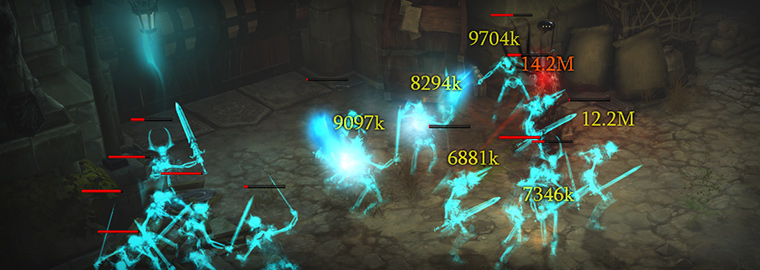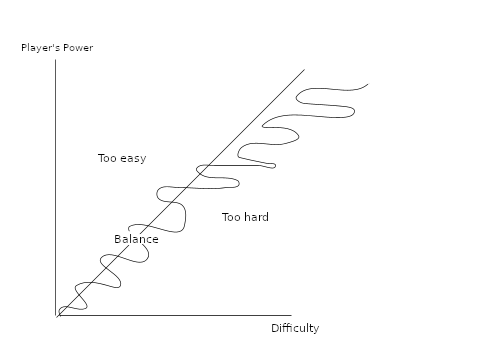29.03.2021
Game Balance for Beginners
Creating a balanced game is harder than it looks. Balance takes into account not only character parameters and economy, but also map size and type, player level, and even the time spent in the video game. There is no recipe for how to create balance in games. Even after 1500 years of chess White still goes first and that gives them a slight advantage.

Diablo 3 is a fast-paced game where every split second count. Its developers discarded the unwieldy 1,000,000 in favor of the more readable 1000k. This approach does not interfere with perception and pleases the player with a beautiful number.
The balance in game design is, first and foremost, design. Don't rush to open Excel as soon as you get an idea for a new game. Think in terms of variables, not numbers. Think about what numbers in the game can change, and what should be taken as a constant.
For those beginning to learn game balance, the following tips will work:
For those beginning to learn game balance, the following tips will work:
1. Parameters of the first-level warrior.
For example, we are doing PvP-oriented MMORPG. Warrior is the most average class. He does not deal damage like a rogue, does not live long like a barbarian, does not use spells as a mage. His power is the amount of damage he can deal in a lifetime.

By adding some parameters and taking others away, you can build other classes based on them. If we increase the attack speed by 10%, take 30% of the health and add them to the damage, we get a rogue that is almost as powerful as a warrior:

It's okay if the power is slightly different. The game, whose balance is just being adjusted, will tolerate more than that.
Later on, the numbers are scaled and the most convenient values are chosen. Here are a few examples:
Later on, the numbers are scaled and the most convenient values are chosen. Here are a few examples:
- The essence of incremental games is to hypnotize with the magic of numbers growth. Therefore, an increase in income by thousands of times in a few minutes is reasonable.
- In RTS on PC, the player counts a lot in his head. For unit parameters, it is better to take small and round numbers.
- Find the golden mean in the calculation of characteristics in RPG. Level up or a new sword should warm the player's soul suddenly increased damage. That said, PvP battles should not be predictable.
2. Reverse engineering isn't always a bad thing
Take a popular video game. Write down all the possible entities in it: parameters, prices, time to create heroes, cost to upgrade. Now sit for a couple of dozen hours and think about how and why it works. Tips that may help you:
- Dig around in the application code and change a few parameters. Test it. What has changed?
- Increase or decrease the parameters by N times.
3. Game balance is everyone and everything.
Not all aspects lend themselves to calculating values in advance. Some problems will only surface at playtests or release at all. For example:
The pace of the story or the complexity of the game. This tip is especially relevant to the balance of complex story games on PC or consoles. Events must be served evenly, otherwise, the player will get confused or lose interest.
- Space imbalance. On large and spacious maps, long-range and maneuverable units will have an advantage. On small and labyrinth-shaped - powerful melee units.
- Metagame. It can arise for many reasons, not always related to the game: a nice model animation and voice acting, fan strategy, a trend introduced by cyber-sportsmen. Players take the same character for no particular reason for the developer. As a result, the whole game changes and loses its variety. Instead of ten possible options, you remain with only one or two.
The pace of the story or the complexity of the game. This tip is especially relevant to the balance of complex story games on PC or consoles. Events must be served evenly, otherwise, the player will get confused or lose interest.
4. Sometimes progress is just an illusion.
Imagine the picture: in sweat, the player is killing monsters/build houses/solving puzzles. Suddenly he finds a new sword/accesses new buildings/understands the algorithm of the game. For a while, he rejoices in his newfound power but then the complexity of the game increases. At first glance, his gameplay looks like this:

In other words, game balance is when the player consumes a unit of content at the same rate at the beginning and end of the game. It looks boring and scary. It seems like a step aside is like an execution. Is this the case?
Jesse Schell, bestselling author of "The Art of Game Design: A Book of Lenses," suggests the following scheme:
Jesse Schell, bestselling author of "The Art of Game Design: A Book of Lenses," suggests the following scheme:

According to him, the player balances complexity and boredom. At first, it looks simple. The first challenge is an opportunity to show off your skills and balance the difficulty. After that, the difficulty drops sharply again so that the player has time to enjoy winning and his skills, and then it gradually increases.
In free-to-play games where in-app purchases are important, the difficulty curve can even look like this:
In free-to-play games where in-app purchases are important, the difficulty curve can even look like this:

Here the player is faced with an important choice: spend more time on leveling or pay and enjoy the game further.
In your spare time start looking for balance (or lack of it) in other people's gaming applications. Doing this is always psychologically easier than doing it on your own. As you begin to master this task - welcome to the position of game designer!
In your spare time start looking for balance (or lack of it) in other people's gaming applications. Doing this is always psychologically easier than doing it on your own. As you begin to master this task - welcome to the position of game designer!
